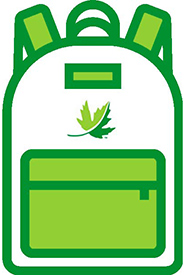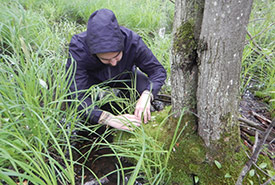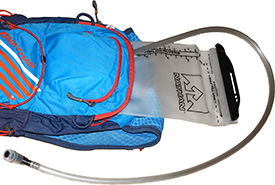Backpack Essentials: Get ready for wetlands

Backpack Essentials (Image by NCC)
This blog post is part of the Backpack Essentials series, a series that explores the items that Nature Conservancy of Canada (NCC) staff carry with them when heading outside. It is inspired by the quarterly Nature Conservancy of Canada Magazine and our Nature Destinations program. To learn more about NCC’s properties across Canada that you can visit, check out naturedestinations.ca.
In the middle of an intensively cultivated agricultural area is a wetland ecosystem that provides habitat for many rare species. This region — named the Clarenceville bog, or tourbière de Clarenceville — is one of Francis Giard’s favourite field locations as a student studying ecology. He especially loves observing the wild, carnivorous plants that are growing on the thick layers of sphagnum moss.
Francis is a stewardship intern for the Nature Conservancy of Canada’s (NCC’s) Quebec Region, assisting us with wetland conservation efforts and the acquisition of new natural areas. He has always had a special appreciation for wetlands, as they hold some of the most fascinating species of carnivorous plants — like pitcher plant and flytrap — that he’s only ever seen in textbooks.
Related blog posts

Francis Giard (Photo by NCC)
Wetlands are incredibly valuable, as they sequester carbon and prevent floods. If you are curious about wetlands and would like to venture out and see these ecosystems yourself, Francis has a few tips about navigating these complex environments.
While the basics like sunscreen, mosquito repellent and rain boots are needed, Francis places the most importance on water. Even though he is surrounded by fresh water when in wetlands, he is cautious about ensuring he has enough drinking water for his long hours in the field.
“In wetlands, dehydration and heatstroke are serious risks,” explained Francis.
Instead of filling water bottles with litres of water, which can be heavy, Francis chooses to carry all of his water supply on his back in a hydration bladder. It’s no effort for him to carry over three litres on his back while moving around in the field.
“Hydration bladders are convenient,” said Francis. “You don’t need to stop to drink, so you don’t lose time.”

Francis chooses to carry all of his water supply on his back in a hydration bladder. (Photo by Tiia Monto/Wikimedia Commons)
Adequate hydration can also reduce the risk of heat exhaustion and heat stroke. In wetlands, there are fewer shaded areas than in forests, making it more likely for you to overheat. Having enough water available — especially in a hydration bladder — may actually save you from these life-threatening conditions.
It may seem like a lot of stuff to bring out into the field, but a hydration bladder helps Francis get ready to tackle the daunting yet fascinating environment of wetlands. In the meantime, you can find him searching for carnivorous plants in the wetlands of Quebec and formulating plans to fight invasive phragmites with NCC.
The Conservation Internship Program is funded in part by the Government of Canada's Summer Work Experience program.


